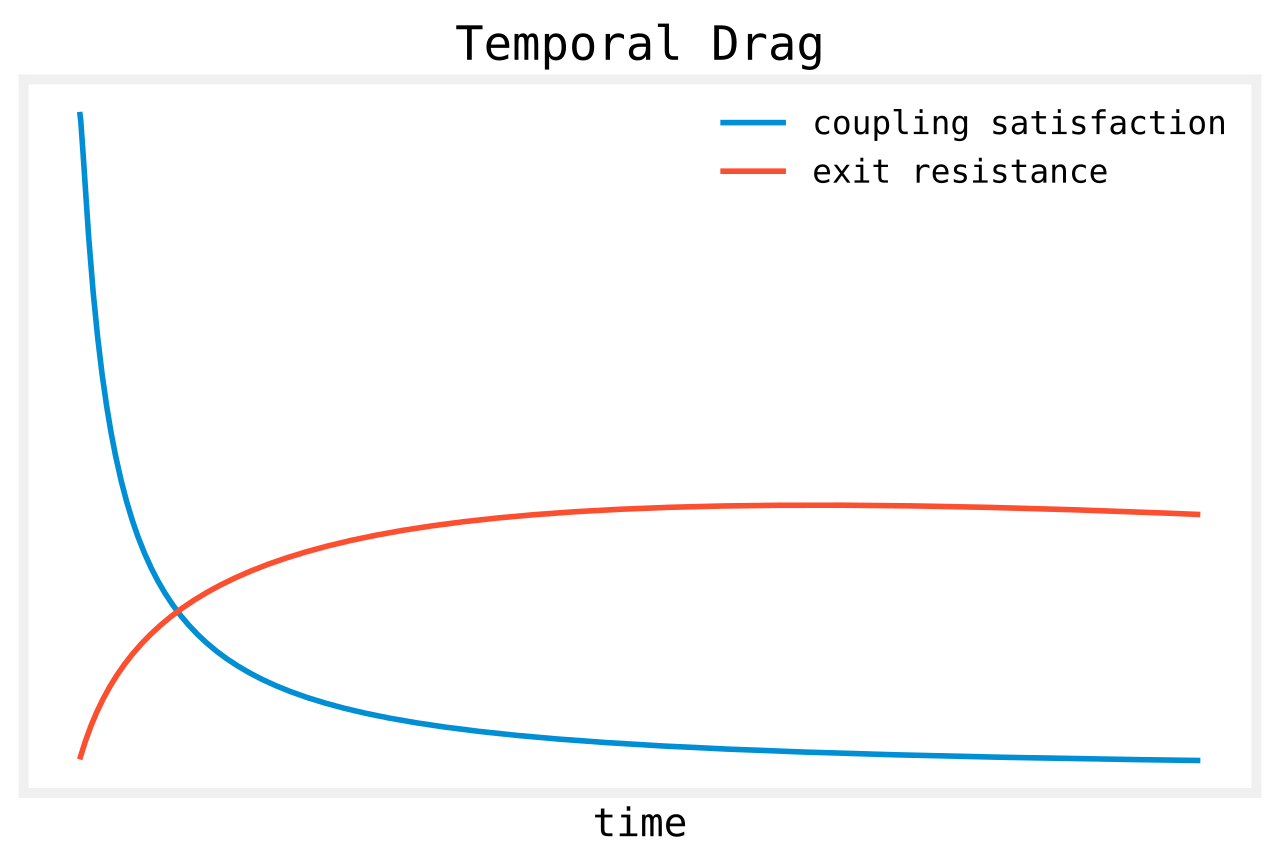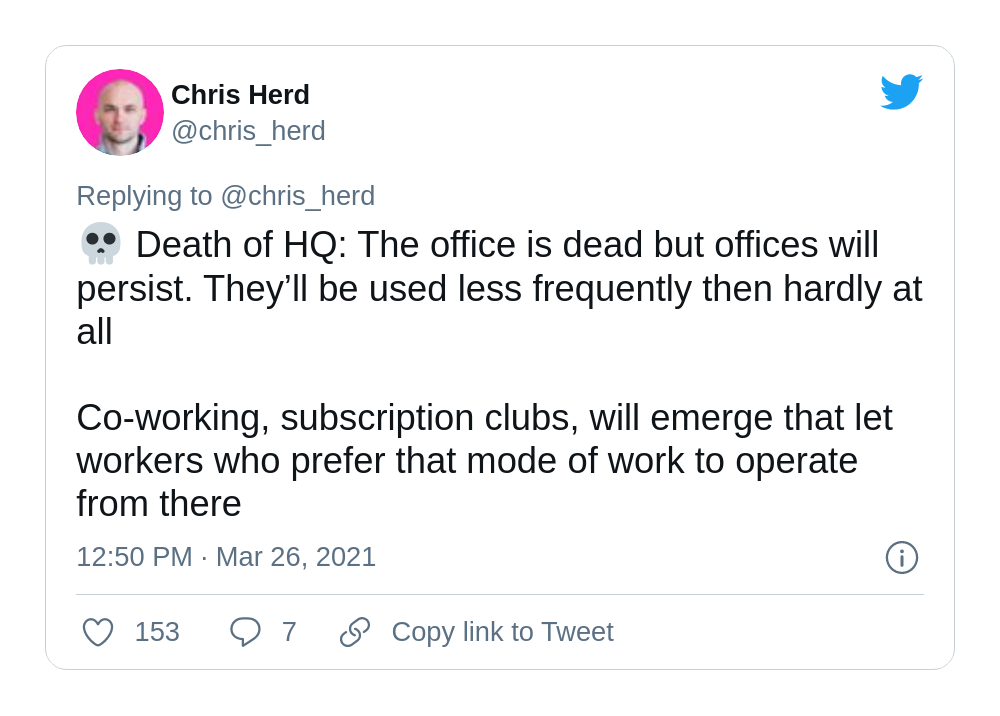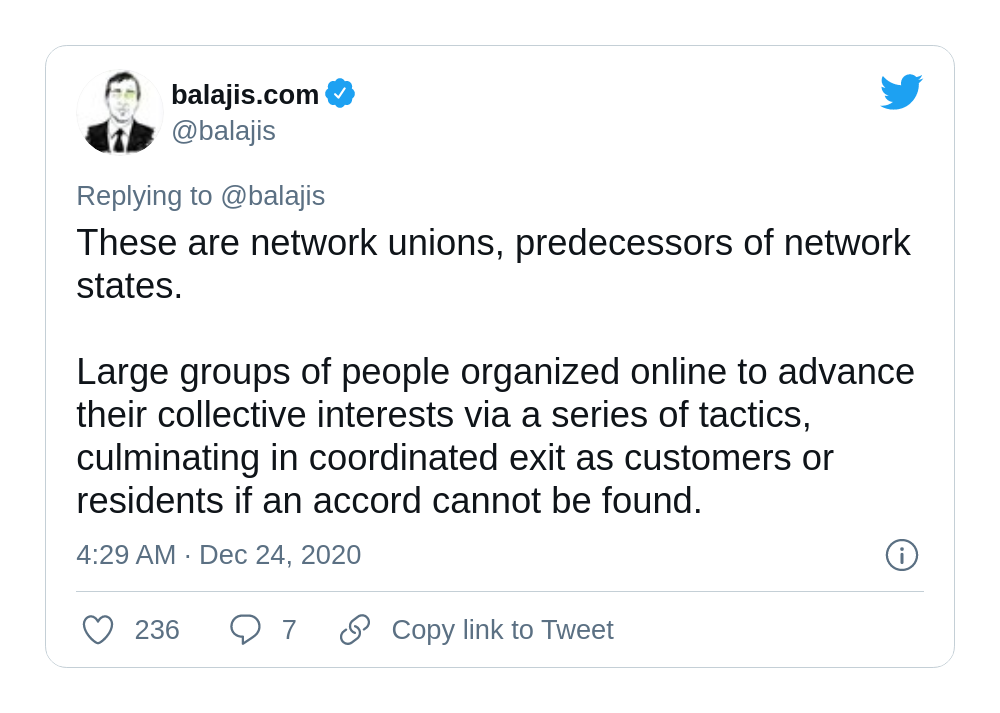Future Of Work
post by specbug (rishit-vora) · 2021-07-19T23:16:20.109Z · LW · GW · 6 commentsThis is a link post for https://sixeleven.in/work
Contents
An Optimisation Problem First Principles Are Hierarchies Inevitable? Temporal Drag Back To The Future Remote Work Freelancing Co-Working Spaces Blockchain Hive Mind Work 2.0 Information Age Will Reverse The Industrial Age None 6 comments
The current employment model is outdated. For the majority of workers, vocation and avocation are incongruent vectors. Here, we describe a set of tools that can be used to form a better-integrated work model, to dispense high-quality work to everyone.
An Optimisation Problem
The number of jobs is ever-mutating. There is no finite number of enterprises being segmented since ancient times. Evolving cultures yield evolving problems, increasing opportunities for innovation. Synchronously, an increasing knowledge base curates more individuals with unique competencies and interests.
So the issue of optimal employment is neither of quantity nor quality. As a crude formulation, we have tasks to be solved and agents to solve them. The problem is optimally matching the agents to solve those tasks — the problem is constrained optimisation.
Constrained optimisation is the process of optimising an objective function with respect to some variables, in the presence of constraints on those variables.
Here, we won't be formulating any linear equations or defining any statistical metrics. Instead, we'll follow a more descriptive approach and peek at a set of components we could leverage. We can gain insights into the solution by gauging the pitfalls of current model.
First Principles
The idea of (voluntarily) working for someone, even at the expense of one's freedom and contentment, is not intrinsic to us. We started out as a tight-knit band of hunter-gatherers, for subsistence, some 200,000 years ago.
The genesis of the Agriculture Age, some 10,000 years ago, conceptualised a tree-like work culture. The following Industrial Age, merely 300 years ago, only concretised the model.
Are Hierarchies Inevitable?
Hierarchies skirt some underlying principles of the work model (to be discussed). To analyse its effects on work efficiency, it is crucial to understand the implications of the question: Why is a company the size that it is?
Ronald Coase argues that the size of a firm depends on finding an optimal balance between the internal transaction costs vs the external transaction costs to the company. A firm can outsource some one-off task, but any resource that requires frequent ministration is better off in-house.
Pre-Information Age, there was friction to outsource some task — constrained by low bandwidth mediums in communication & commute. Hence, it was practical to have a large assortment of workforce on-premise. Such a workforce, left unchecked, yielded sub-optimal outputs. In turn, inducing the need for middle managers (or a top-down hierarchy) to scaffold it.
Top-down management was efficient in herding the workforce. Also, hierarchies thrived in competitive markets, as they reinforce structure and regularity.
However, inherent to a Hierarchy are also factors that inflate inefficiencies. People in Hierarchy tend to rise to their level of incompetence. A competent person will earn a promotion to a position that requires different skills, even though skills in one job do not necessarily translate to another. Also, as tending to managers became the face of "mastery", the game was renamed from savviness to sycophancy.
This, of course, is not a novel viewpoint; such shortcomings have propelled multiple firms to adopt a form of no-boss protocol. But the problem is not a hierarchy itself. Some parameters of the current model poorly conflate with Hierarchy to catalyse the above issues. The goal is to leverage utilities that prune the minuses while maintaining the pluses.
Temporal Drag
Another inefficiency stimulated by the current model is a temporal drag.
The process of exiting a firm is tedious. Notice periods, a sunk cost bias, anticipated dread of job hunting, and uncertainty of better opportunities lead to a drag. Hence, there comes a threshold after which an employee is just coasting through (minimal engine utilisation) until he runs out of fuel / jumps ship. While the probation period is meant to minimise this disposition, the nature of the period makes it akin to a "honeymoon phase". There is overcompensation in leeway, understanding and enthusiasm, among both parties, during the period. A false painting.
On the other hand, entering a firm is a gamble. A good analogy is to contrast a worker and a firm to a refugee and a country, respectively. The refugee scouts multiple countries for refuge. The nation has its own inflow of applications and limits. They both carry a bias of expectations from the other. The refugee bears unique skillsets. The country has a set of opportunities that may or may not intersect with it.
Unfortunately, the game is rigged in favour of the country. The line of communication is thin and transient, and the stakes (for the refugee) are high. This makes the line ripe with hypocrisy and false expectation setting. A veil separates reality, and both parties (the refugee majorly) curate their silhouette to suit the other. The eventual dissolving of veils, in turn, lead to disappointment.
TLDR; Entry is volatile and based on false expectations. Exit has resistance enough to stale progress. The following hypothetical graphs depict the friction:

Sprinkle into the mix, pitfalls like incentive optimisation, principal-agent problem, low novel-to-repetitive work ratio, etc. Exhaustiveness is beyond the scope of this essay. We can, however, summarise most of these issues under two classes:
- Internal-external transaction cost
- Entry-exit latency offset
These ratios are subject to the constraints of tools and technologies of an era. Well, the Information Era has optimised traversing through spacetime. Utilising some internet-enabled tools, we can innovate differentiated solutions to these challenges.
Back To The Future
We'll skim through a tensor of internet-enabled components for our work model. We will define them through the lens of 'work'. Building up to an integrated worldview that leverages all these Legos:
Remote Work
A thought experiment pre-Covid, but the logistics of the system are very well defined now. Output is a function of creativity and freedom — remote work enables conjunction of autonomies:
- Wherever you want. Proximity to close ones, cost-effective living, habitat experimentation, digital nomadism, etc.
- Whenever you want. No 9-5 closed loops, no game-face politics, asynchronous work, a balanced work-circadian rhythm schema, no physical constraints, etc.
- However you want. Prioritise comfort over paradigms. The quirky SV entrepreneurs in their shorts and hoodies will be aesthetic outliers no more.
The need to pad out your 8 hour day will evaporate. Workers will do what needs to be done rather than wasting their trying to look busy with the rest of the office.
Serendipity (water-cooler rooms), a productive chamber void, socialisation, etc., though well-founded, are conservative anchors. They can be circumnavigated via virtual apps. The components below confront some of these anchors.
Freelancing
Specialisation is for insects. The freedom to experiment with the exploration v. exploitation slider is fundamental to Sapiens. Freelancing augments yet atomises the domain of opportunities. It enables dry-runs, A/B testing, and rapid turnovers without long-term bonds. Contrast that to a traditional job, where there's an exponential decay of novelty with time and a high turnover resistance.
Conventional plugins in a firm will be replaced by micro-tasks. Why onboard someone for a stint, if you can leverage a distributed team of specialised personnel. Sacrificing a non-trivial percentage of our life to a single task/firm/type of work will seem ridiculous.
Co-Working Spaces
WeWork for individuals. A proliferation of HackerSpaces will override traditional offices. Disrupting the issues surrounding socialisation, offering a productivity rich dome, and pruning the drawbacks of offices. Equipped with pool tables, gyms, telepresence robots, medical facilities, canteens, etc., they will moot perks as leverage. Such spaces will expand and override traditional offices. Travelling for work is an endangered notion.
Co-working with your teammates will be a choice. An entire firm might converge to the same space, subject to their interests. The formation of LLCs, under the co-working umbrella, will be a consequence of optimisation.

Blockchain
A blockchain induces skin in the game. Essentially, all write calls to a blockchain have a tag price.
A job listings application, built on a blockchain, is a catalyst for quality over quantity. No more generic listings, template CVs, or a frenzy of choppy applications. As a consequence, expect meticulously outlined postings with chiselled specifications. Assignments will best emulate the actual work expectations. The gravity of the overall process will be higher, follow-ups will be a norm.
Cryptocurrencies will replace fiat for salaries. It'll crop some of the political, financial and geographical issues that underlie a global workforce. Smart contracts integrated into micro-tasks will eliminate human errors.
Hive Mind
Imagine a subreddit with a self-contained Kickstarter and the clout of a state.
Siloed physically, integrated virtually. Forms of distributed autonomous organisations — an independent, self-contained union of like-minded individuals — will spawn innovative opportunities.
Distributed cul-de-sacs will render location unimportant. Coined by a gaussian distribution of notions, responsible for voicing, funding and executing collective interests. A hive mind will be a hotspot for pertinent opportunities.

The above systems have overlapping target vectors. There is already a partial intersection of these systems in gig work, WFH, digital nomadism, etc. The goal is to transition thoroughly, with a wide impact radius.
Work 2.0
Tradition is the glue that holds our civilisation. Unperturbed, however, it sets the stage for inefficiencies to creep in. The traditional work model produced excellent enterprises and paved the way for an exponential industry. But we've crossed the threshold of the gain-loss ratio (< 1). We need to update the model parameters by exercising these synchronic utilities.
Alluded to earlier, we can define the objective of our optimisation problem as a function of work satisfaction, output and freedom. A person who works on what he wants, when he wants, without commitment offsets, better leveraging his skillsets and aspirations (over a single, disproportionate metric of cajoling proficiency) — will produce more quality output, per unit time.
Information Age Will Reverse The Industrial Age
Naval paints a good picture (paraphrasing him):
In the future, high-quality work will be available in a gig fashion. You'll wake up, have five different job offerings from ex-colleagues, or people who've been referred to you. You choose to accept/reject the project, the contract is right there on the spot, you get paid a certain amount, and get rated regularly (sort of how Hollywood already works). And when you're done working, you turn off your systems, collect your paycheque, and go to Tahiti or wherever; where you rest and reassess for the next sprint. This model of grazing 9-5 is for machines, we're meant to hunt in a tight-knit band of like-minded individuals (like lions).
6 comments
Comments sorted by top scores.
comment by Dagon · 2021-07-24T01:17:54.060Z · LW(p) · GW(p)
I think you're undervaluing the cultural expectations of availability and cooperation during core work hours. And the value to workers of contractual pay (for which employers demand contractual hours). You're also forgetting the hidden-value alignment brought on by the expectation of a recurring long-term relationship. It's hard to monitor most work in the short term, so having the engagements be longer-term makes it possible to adjust job and compensation based on years' of output rather than the latest delivery.
There certainly is more work than many think which can effectively be done piecemeal. But there's lots more than you seem to acknowledge that is pretty well optimized by current norms.
Replies from: rishit-vora↑ comment by specbug (rishit-vora) · 2021-07-25T04:29:46.915Z · LW(p) · GW(p)
It's hard to monitor most work in the short term, so having the engagements be longer-term makes it possible to adjust job and compensation based on years' of output rather than the latest delivery.
Fair point. I agree, I am exaggerating the effectiveness of certain elements. And downplaying the necessity of others.
Although, there's an inherent survivorship bias to favour a longer-term contract, because we've never experienced an efficient short-term engagement model, at scale, before. But I do believe this adjustment buffer will shorten with time, as the tendency of finer hiring accelerates. And, short-term alignment and work efficiency will increase, as everyone adapts to a "faster" work culture.
comment by Viliam · 2021-07-21T13:20:37.236Z · LW(p) · GW(p)
The need to pad out your 8 hour day will evaporate. Workers will do what needs to be done rather than wasting their trying to look busy with the rest of the office.
Remote work does not necessarily eliminate the pressure on workers to look busy for 8 hours a day.
Instant-messaging tools often show when you are "active" and when you are "away". If you are using a company computer without administrator rights, this effectively becomes a check when you are busy (typing on the keyboard, moving the mouse), even in countries where monitoring your employees is in theory illegal. If the circle next to your name is too often yellow when the circles next to your colleagues' names are green, some manager will notice.
Even if you install a mouse shaker, if the managers have a habit of sending instant messages to employees several times a day and expecting an immediate response, they will notice who replies quickly and who does not.
With long meetings, the company can make sure that employees are actually paying attention by introducing group activities, where the employees are split into groups of five, and they are supposed to brainstorm on given topic and afterwards report their team conclusion.
Replies from: rishit-vora↑ comment by specbug (rishit-vora) · 2021-07-25T04:09:25.358Z · LW(p) · GW(p)
Yes but there's generally a long enough buffer before the messenger apps change status.
Working on something personal, reading some blog, general web surfing, etc., I feel, constitute 80% of "alt work" sessions. These scenarios won't register on instant-messenger as "away". It is not about going out for a one-hour walk in the middle of the day, without informing anyone. It is these bursts of freedom, and the ability to switch context, unmonitored.
Also, pinging someone for feedback, checking someone's status or organizing group activities, seems like a less efficient monitoring medium (over constantly being in their range of vision).
Replies from: ChristianKl, Viliam↑ comment by ChristianKl · 2021-07-25T11:20:34.845Z · LW(p) · GW(p)
Working on something personal, reading some blog, general web surfing
That's also what people do at the office.
↑ comment by Viliam · 2021-07-26T13:41:54.609Z · LW(p) · GW(p)
The personal activities available during the 8 hours monitored by instant messengers involve mouse and keyboard.
Possible: reading a blog, commenting on a blog, writing a blog, watching YouTube videos, reading a book in PDF, doing an online course that does not require installing anything, etc.
Not possible: taking a nap, exercising, taking a walk, cooking, etc.
The thing I find sad is that all healthy activities seem to be in the latter group. For someone who wants to spend most of the day browsing Reddit and watching cat videos, work from home is a complete blessing. For someone who wants to take care of their health (maybe damaged by years of sedentary work), there are still many advantages (e.g. freedom to choose a chair or standing desk, plus all the useful things in the former group), but the 8-hour block still remains an obstacle to some activities.